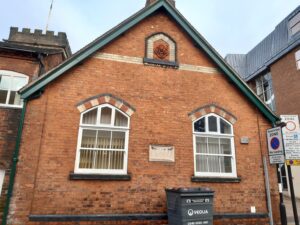Have you ever wondered about a local building, an old pub or even your own house and who lived there years ago?
The history of a house can be fascinating. Depending on the age of the building and sometimes location, the amount of history within those walls is really interesting.
And, there are lots of resources out there to research and discover!

© J Kenyon, 2022.
So, who did live in your house in 1939? in 1921? even in 1841??
As a house historian, I have researched 2 houses recently, one a public house and the other a private residence in Lancashire. The above picture is of St Chad’s Schoolhouse in Stafford. The datestone gives a great clue, but often these are not on a house or building.
How to research your house or building:
Here are some resources that I have found helpful and which will assist you in finding out more about a property:
- Firstly, start with what you know and work backwards through time. Make a list, or produce a log of everything you have researched, that way you can go back over what you have found and resources you have still to find. This can be useful in producing a timeline once the research has been collated.
- Obtain more recent information through deeds or from the Land Registry. Title deeds are available along with an outline of the land and building in question, in the form of a plan/map.
An external link to the Land Registry online search portal is here: Land Registry - Look at census (available to access online with subscription FindMyPast/Ancestry) 1841-1921. With the recent release of the 1921 census, a thorough search could be made. Knowing the enumeration district the building was in at the time of the census will narrow down having to search through hundreds of pages.
- Use the 1939 Register, a substitute type census, through FindMyPast or Ancestry (subscription required) and can be searched by location or name.
- Maps are a great resource. Look for recent maps online and consult the National Library of Scotland maps for earlier dates, which are free to use online.
Zoom in and get a real sense of what was in the immediate and local surroundings at that time. Earlier maps called Tithe maps and apportionments detail land owners, their tenants and often the map will detail plot numbers (The Genealogist has a great collection of these available online as part of their subscription). - Consult wills and probate details. They often mention an address of the deceased, or mention executors and heirs. Equally, family estate papers may reveal further insight into a buildings former use and occupants.
- Rate books and valuation surveys can be useful. Available through the National Archives at Kew and local archives.
- Newspapers are another great way of searching for a particular person, or building, especially if the house had a great name or was a hotel! FindMyPast and The British Library are great repositories for discovering newspapers for the UK and further afield.
- Sales and auction catalogues are a really good resource if you can find them relating to a house or building – or possibly next door! Think about the area at the time, regeneration, new buildings being erected and businesses. Trade directories and gazettes are another useful resource that list trades, occupations and businesses in the locality of your search.
- Local museums, archives and libraries may have further information or point you in the right direction for where to look both online and in larger archives. Ask the librarian or museum curator for some help in locating additional records.
These are just a few of the records and databases that are available and will assist in finding a location or the actual building being researched.

Have you a building or house you would love to know a little more about? Who was living in the house? What was the building used for in previous years? All questions that can be researched and investigated further.
If you would like some assistance in researching house history or genealogy, then please contact me for further details.